Praying mantises are cool – I think that’s an opinion I can safely say is shared between many animal enthusiasts. Out of all the hundreds of thousands of insects known to science, probably no group is equal parts so peculiar and charismatic as Order Mantodea, the mantises. It’s only natural, then, that a number of toy and collectible animal brands have tackled mantises and continue to do so. One of Bandai’s prominent Gashapon toy lines, the Diversity of Life series, has released several mantis sets already, with the most recent one having been released in the summer of 2023 after being announced at the beginning of the year. How does the new set stand for collectors, be they newcomers to this line or “veterans” who have older sets already?
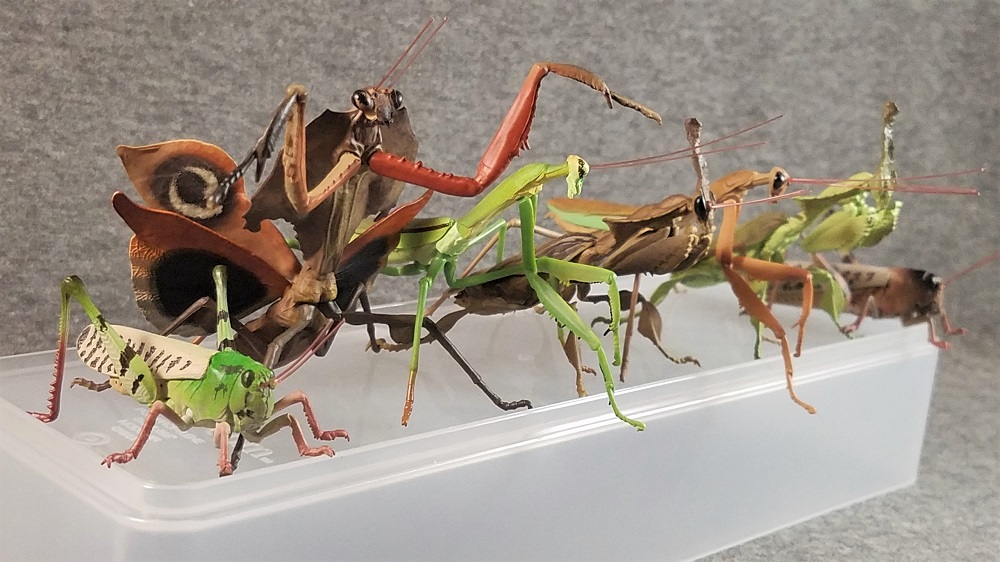
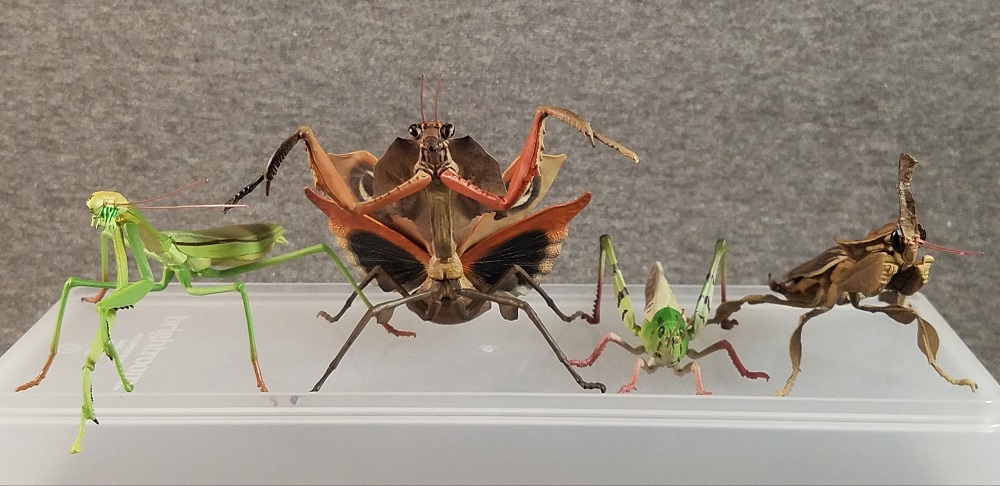
Mini Insects 02 is, as the name suggests, the second set of insect models released under the “Mini Collection” sub-series – part of Bandai’s larger Diversity of Life on Earth (aka Ikimono Encyclopedia) series. Seven models are included, featuring three mantis species as well as one species of locust. Each model was purchasable individually through Bandai’s official website, or could be pursued through standard Gachapon machines carrying the line at various locations throughout Japan. Copies acquired through Gachapon machines would naturally be enclosed in a Gachapon plastic ball; mine were purchased as a set, each model sealed in plastic baggies but eschewing the balls. Minor assembly is required, consisting usually of each body segment – head, thorax, abdomen – and each leg, attaching to the thorax. Assembly is very straightforward, with general instructions included for assistance; however not all the pieces on my figurines were evenly cut, so some patience was needed in the process. Unlike the larger “Advanced” sub-line, these “Mini” figures are generally not articulated, and due to their size and delicate shape should be handled with care before and after assembly.

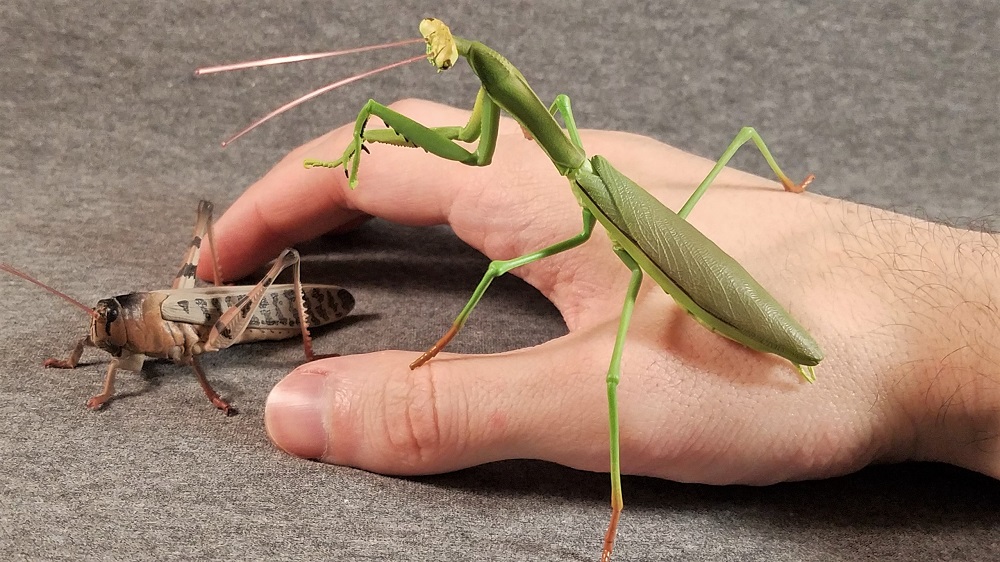
Three of the four species represented in the set come in two color variants; the exception to this is no.1 of the set and the flagship piece, Deroplatys desiccata. Commonly known as the giant dead leaf mantis or the medamakare palm mantis, D. desiccata is the type species for the Deroplatys genus, and is wildly distributed through parts of Southeast Asia including Thailand, Malaysia, Java, and Borneo. D. desiccata gets its “dead leaf” common name from its body camouflage, while its Japanese common name (メダマカレハカマキリ, roughly “medama kareha kamakiri” or medama leaf/palm mantis) alludes to the eye-spot symbols on the undersides of the insect’s wings when it goes into full display posture. The species is a popular one in the pet trade, making for a reliable and recognizable figurine choice for more experienced collectors.

The Mini D. desiccata measures roughly 75 mm (7.5 cm, 3 in) from head to abdomen – which is smaller than Bandai’s other “Advanced”-line representations of the species, but actually fits perfectly within 1:1 scale for a real-life specimen of a mature female. The model’s sex is identifiable by the shape of its prothorax, which is the extended segment of the thorax bearing the signature grasping legs. Female D. desiccatas have larger “shields” than males, with curved edges somewhat resembling the outline of a worn arrowhead. Other distinguishing traits include the robust abdomen and (relatively) short wings.

Bandai produced their molds for the insects through precise CT scanning of real specimens, and the detail clearly shows. The surface body and wings is exquisitely textured in fine, slightly irregular patterns of grooves and veins that perfectly resemble the look and feel of a fallen leaf. The secondary wings bear an even higher level of texturing, while every joint and segment of the body and limbs is accounted for. Individual claws, thorns, and flaps are molded on each leg, and even the mandibles have distinguishable parts. The only features belying the toyetic nature of the model are the trim plastic antennae and the copyright engravings under the rear end.
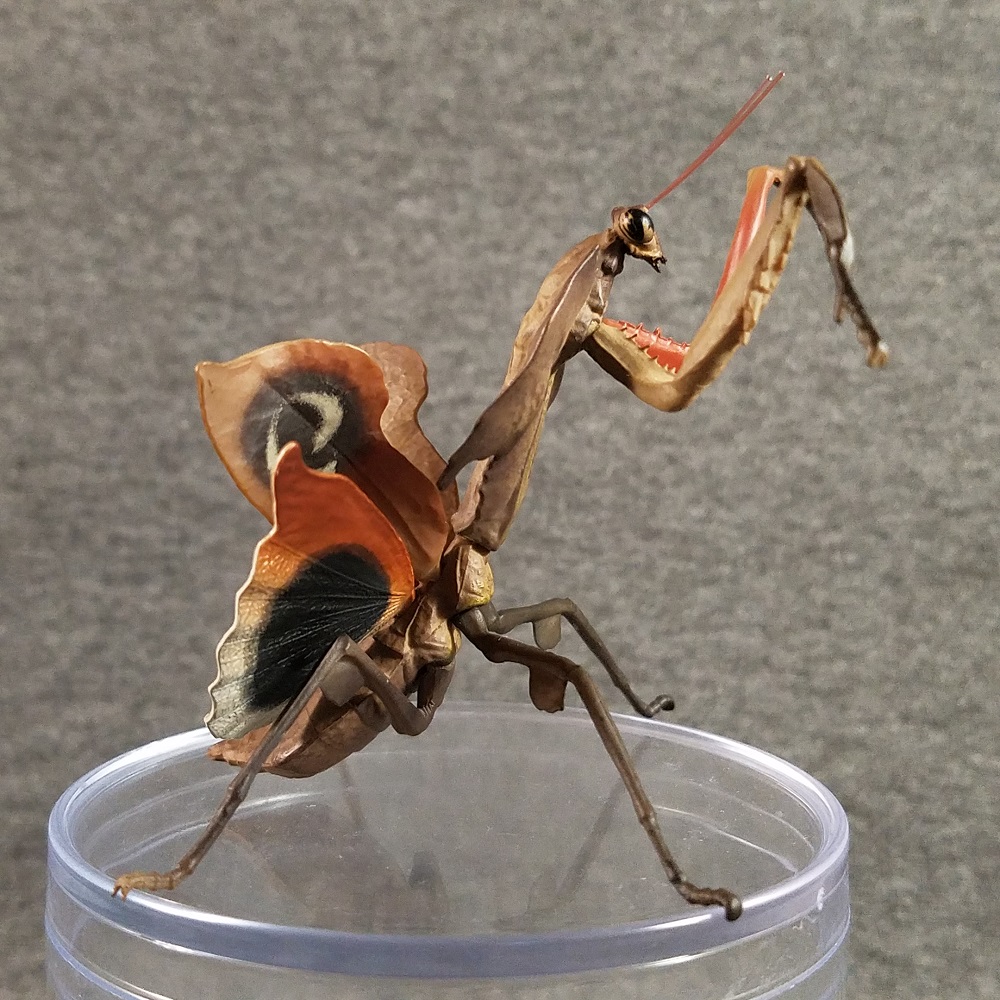
Paint applications are similarly superb. Coloration can vary in nuances between live mantises, but the Bandai model captures all the essentials: an earthy brown body with darker-gradient wash, black-patterned eyes, and rusty red highlights on the front legs. The wings are spread in full display, so the 9-shaped eye-spots are clearly visible in stark black-and-white on the upper wings, with a larger solid black spot on each lower wing, bordered by white that gradates to red. It’s easy to picture this model as a living mantis, invisible on the forest floor at rest, only to suddenly spring into vibrant action in defense against an enemy. This model on its own is an absolute winner.

Figurines no. 02 & 03 feature the less elaborate, but very familiar Tenodera aridifolia – commonly known as the Giant Japanese Mantis. T. aridifolia is widespread throughout Asia, and is sometimes cited as being distributed in the USA too – although this might be confusion with the Chinese mantis, T. sinensis, which was previously considered a subspecies of aridifolia (insect experts are welcomed to weigh in on this, as my own research was limited).
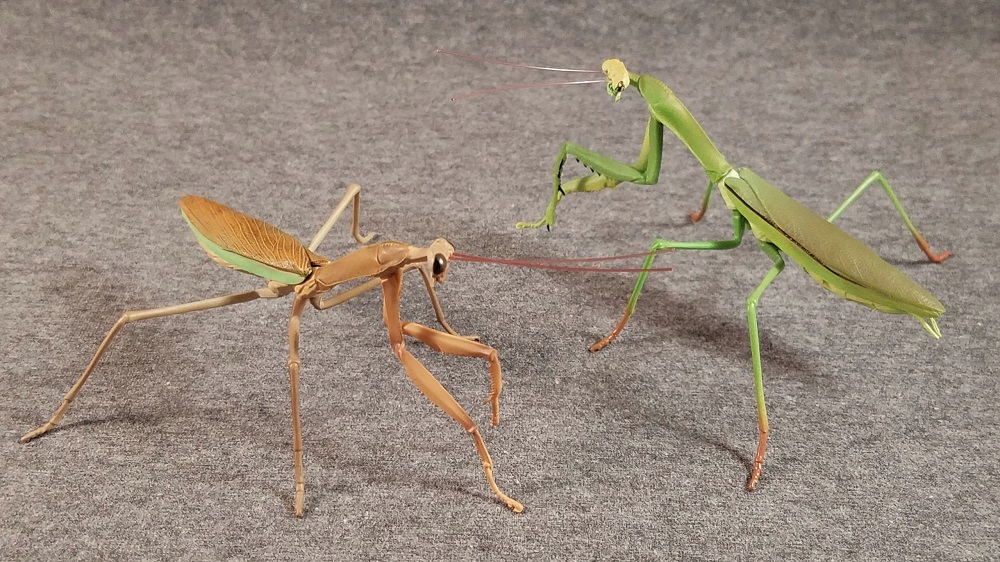
The two figurines measure roughly 80 mm from head to abdomen, which is within 1:1 scale for both male and female T. aridifolia specimens on the larger side. The sculpts are identical, posed with forelimbs extended and head turned in an inquisitive-looking manner. The four hind legs keep each figurine completely balanced, although the right forelimb can reach the ground as well. Detailing is once again exquisite, capturing the minutiae of the mantis’s mouth-parts, arm spurs, and various textures on the body segments. One can run a finger along the back and down to the folded wings, picking up the grooves & ridges of the exoskeleton, followed by the intricate veins of the wings. The four hind legs look slightly less detailed than the rest of the body parts, but every segment down to the claws is still accounted for.
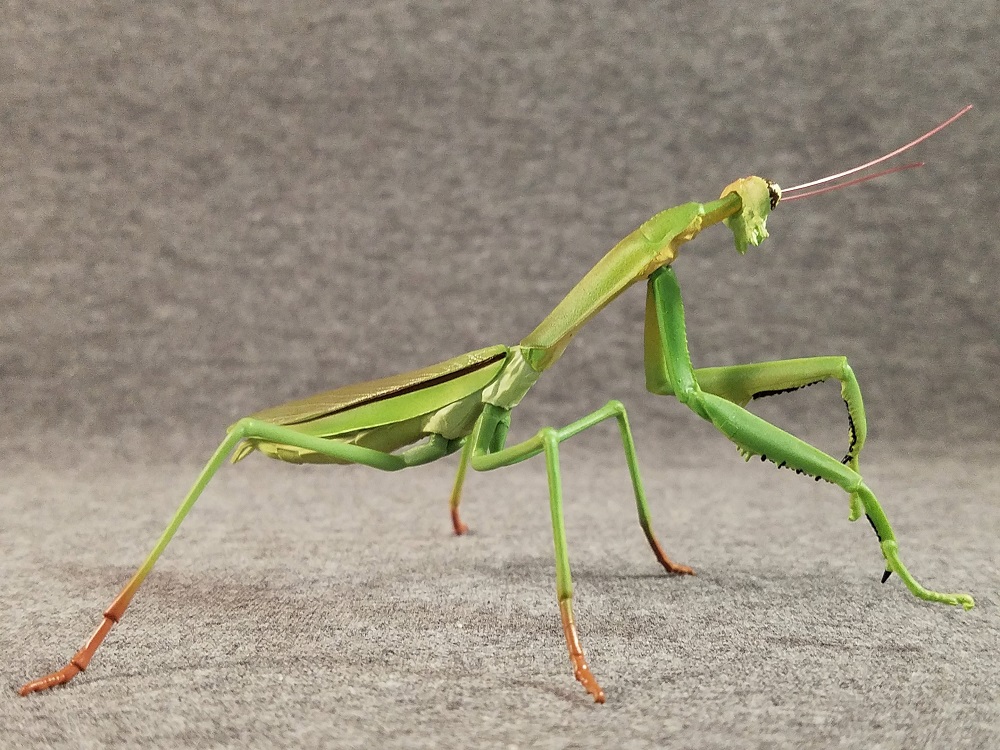
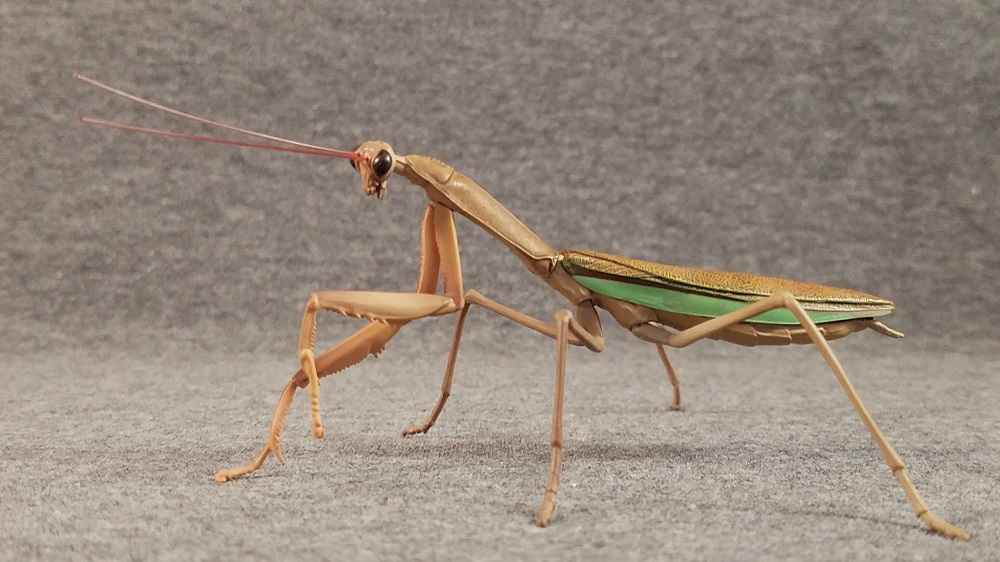
Although not as spectacular in appearance as the displaying Deroplatys, Bandai’s T. aridifolia figurines don’t skimp on paint details either. The two figurines come in green and brown versions, presumably depicting a female and male, respectively. The green female is a healthy grass-green with darker brownish spray on the back, and light yellow highlights underneath. More yellow present on the head, in addition to some pure green striping to highlight the texture of the exoskeleton. Smattered black highlights mark the larger compound eyes; the effect looks a bit cruder than the rest of the figurine, but it’s serviceable. More black highlights mark the large grasping spikes on the forelimbs to greater effect, and the feet transition naturally to a ruddy brown.
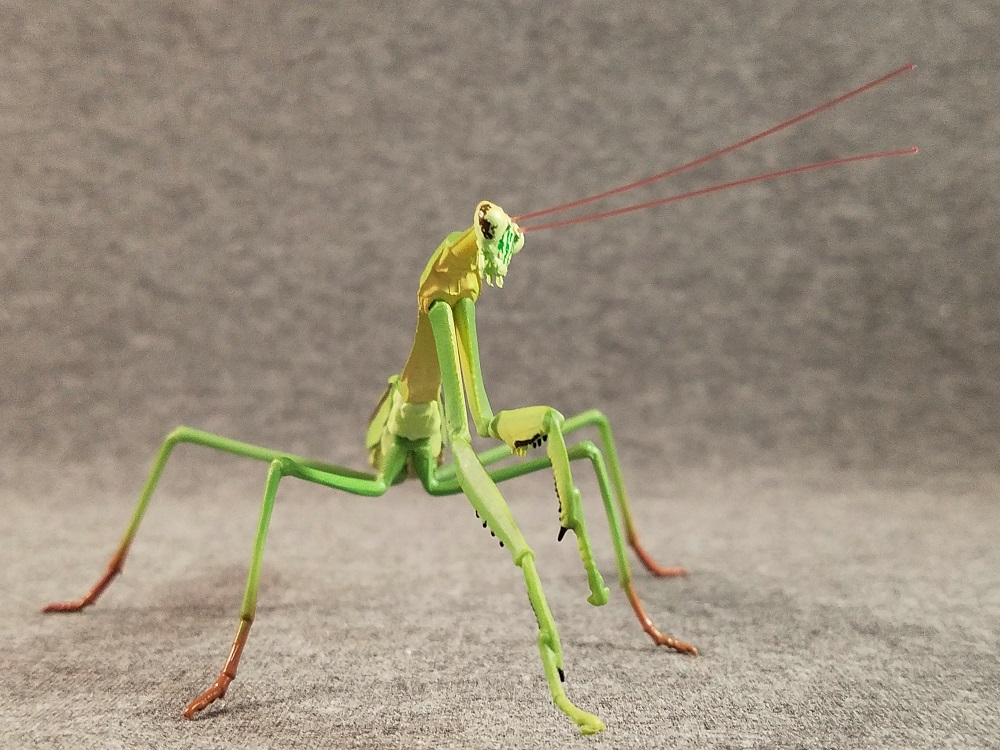
The brown male has a similar “dead leaf” shade to the Deroplatys, with a carefully-applied dark wash bringing out the finest sculpt details on the thorax and wings. The compound eyes appear solid black, but upon close inspection they are in fact a very dark brown with black trim. The forelimbs have fewer paint highlights, but the abdomen’s underside displays a lime green stripe running the abdomen’s length, and the exposed edges of the secondary wings pop with a saturated green, as is seen in so many live individuals. One could easy mistake either of these T. aridifolia figurines for the real thing at a glance.
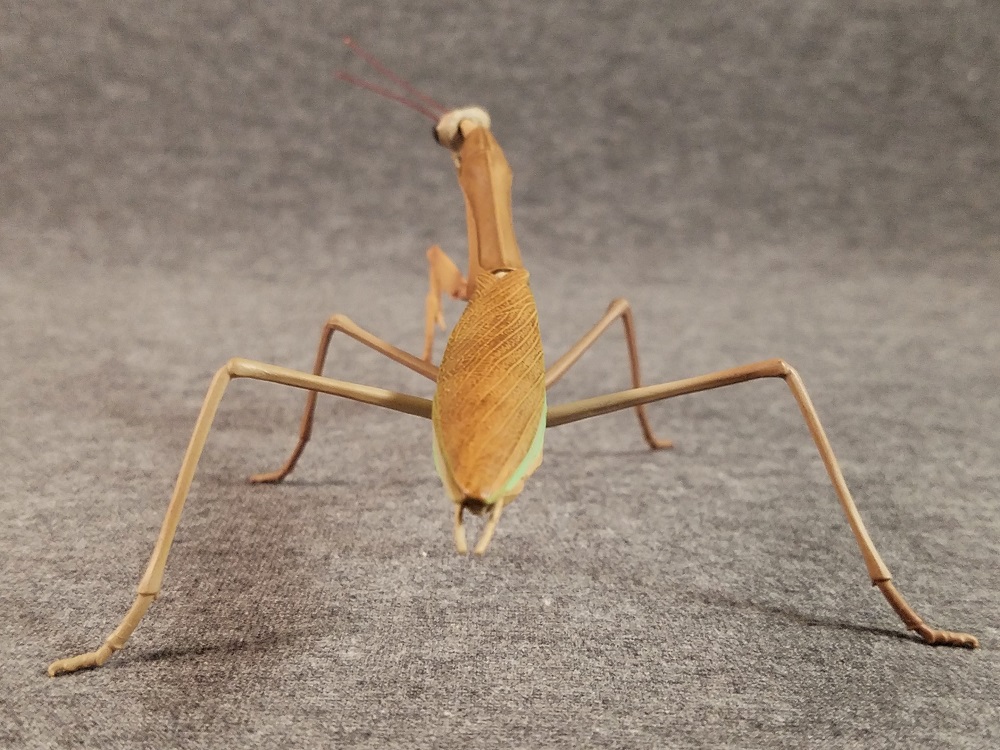

If T. aridifolia represents the “normal” mantis appearance, then Phyllocrania paradoxa is a fine example of the group’s weirder potential. Commonly known as the ghost mantis, or Bōrei kamakiri (亡霊カマキリ, literally “ghost praying mantis” to my knowledge) in Japan, P. paradoxa is represented by figurines 04 & 05 in the Mini Collection set. This species is native to Africa and Madagascar, rather than Asia; but it is another species that has gained presence in the pet trade. Although bizarrely shaped at a glance, the ghost mantis actually resembles the dead leaf mantis in how its shape mimics… well, dead leaves! What appears alien in isolation becomes masterful camouflage in the insects’ natural environment.
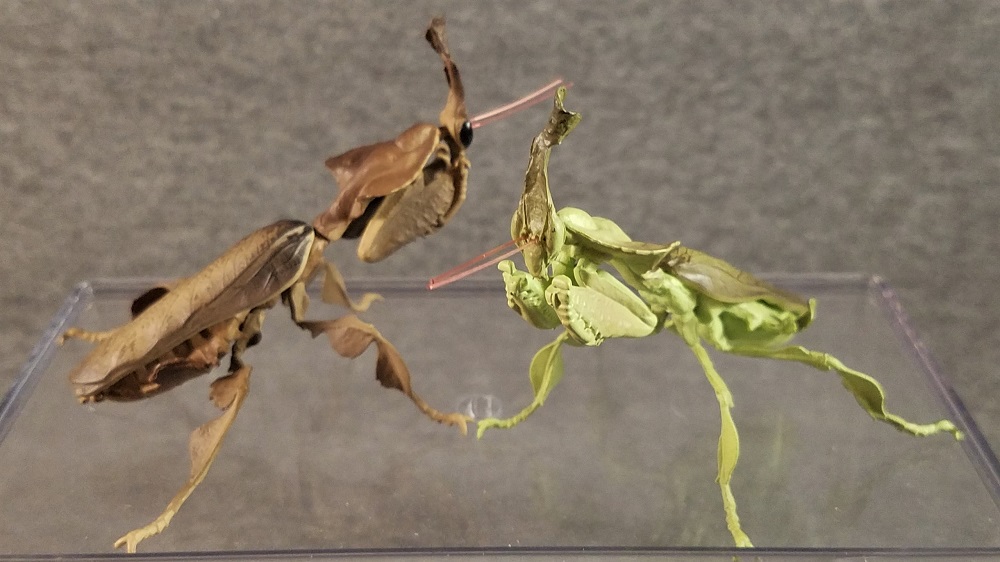
Both figurines in the Bandai set appear to represent females, having stout abdomens with six segments and relatively short wings. Measuring 68 mm straight from head to wingtip, these figurines are actually on the large size for ghost mantises of either gender, which are usually under 50 mm in length. The boost in size probably does a favor to the sculpts, though, by allowing the ever-so-fine details to be more easily visible and appreciated. The mantises are poised to strike, front limbs cocked and loaded, four hind legs spread and planted. The head is perfectly perpendicular to the angle of the body, with the jagged “crest” and pointed tips of the thorax obfuscating the silhouette into something more (or less?) than insect. Ample crunchy-leaf ridges, divots, prickles, and frills are replicated to near perfection, once again giving the mantises an extraordinary fragile but lifelike appearance. The only details betraying their artificial nature (besides the plasticky antennae) are the front legs, which are folded up and inevitably look molded as solid pieces; even then, one can make out the fine barbs and spines sculpted in for grasping prey.
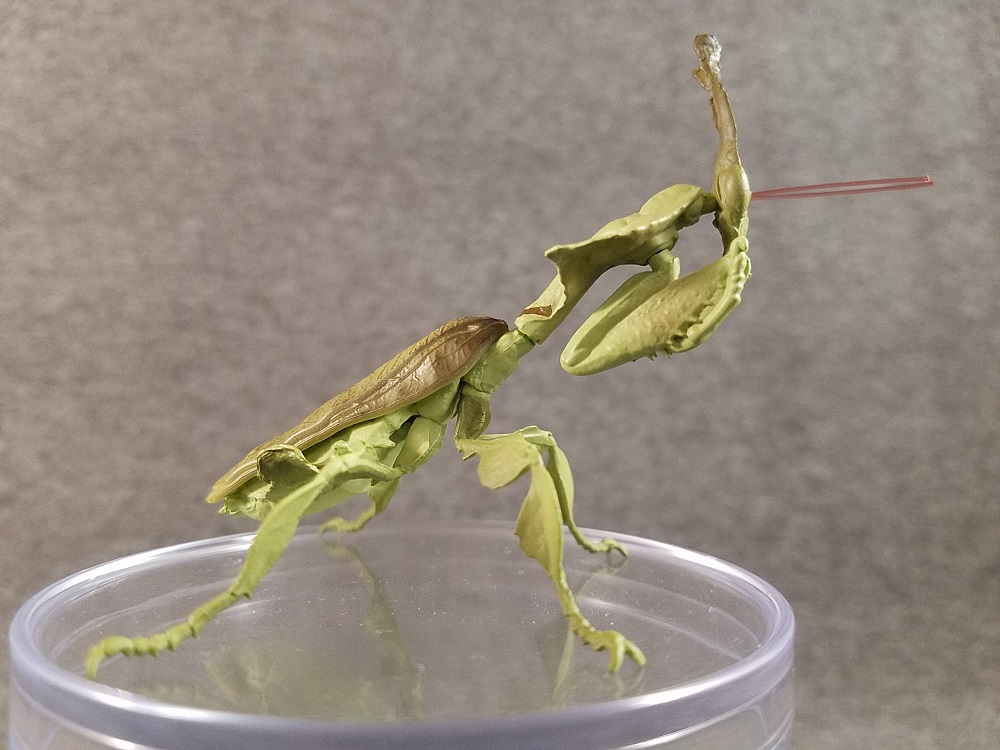
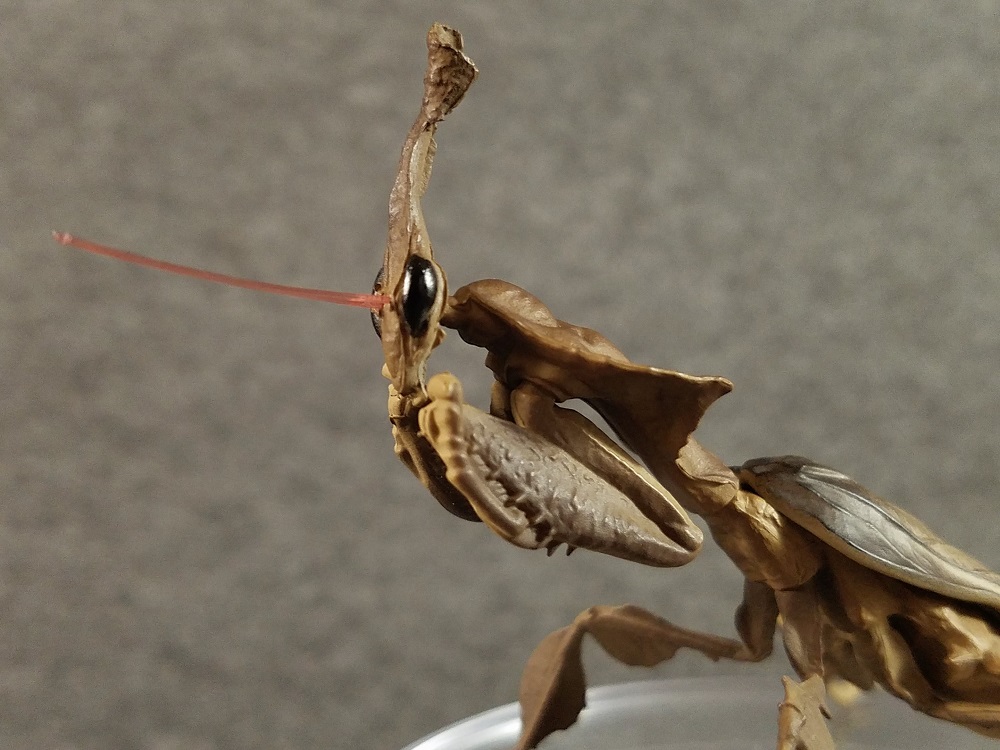
Phyllocrania paradoxa is most commonly found in hues of black and brown, with green individuals being rarer. For the Mini Insect set, the two P. paradoxa are painted in brown and green, consitent with the other figurines included. The brown ghost mantis is the perfect hue of tannin-rich dead foliage, with dark washes accentuating the wings and bodily edges. The figurine is very monochromatic overall, with only the jet-black eyes popping out from the figure’s image. The green variant lacks these black eyes; instead the eyes are the same light green as most of the body. While green eyes aren’t inaccurate for the species, it’s a bit of a detriment to the figurine in my opinion, since it means less color detail to distinguish with. The dark brownish-green highlights are a little more prominent on this version than the brown one, however, so the body overall has more contrast. In a way, the two ghost mantises are simultaneously the most striking and most unassuming mantises in this set.
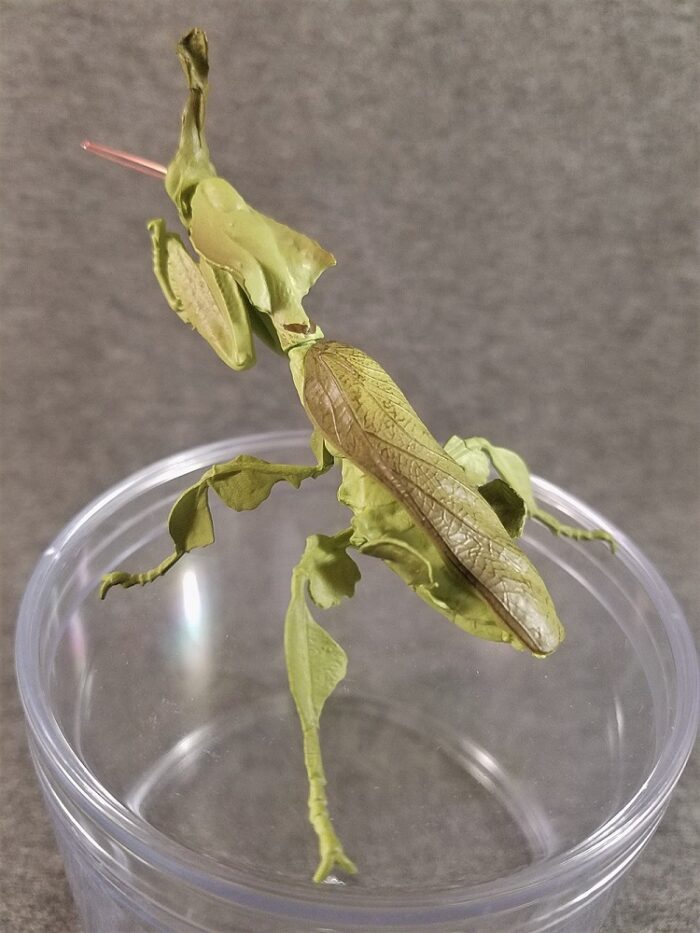

I’ve been talking about mantises for the entire length of this review, but the final two figurines in the Mini Insect Collection 02 aren’t mantises at all. Figurines 06 and 07 represent an entirely different insect: Locusta migratoria, or migratory locusts. Known to travel in large groups (as locusts in general are infamous for), L. migratoria can be found throughout Africa and Asia, all the way to Japan, favoring riverbeds for their resting places. Although superficially similar in appearance to mantises with their long limbs and color patterns, the two kinds of insects are not closely related.
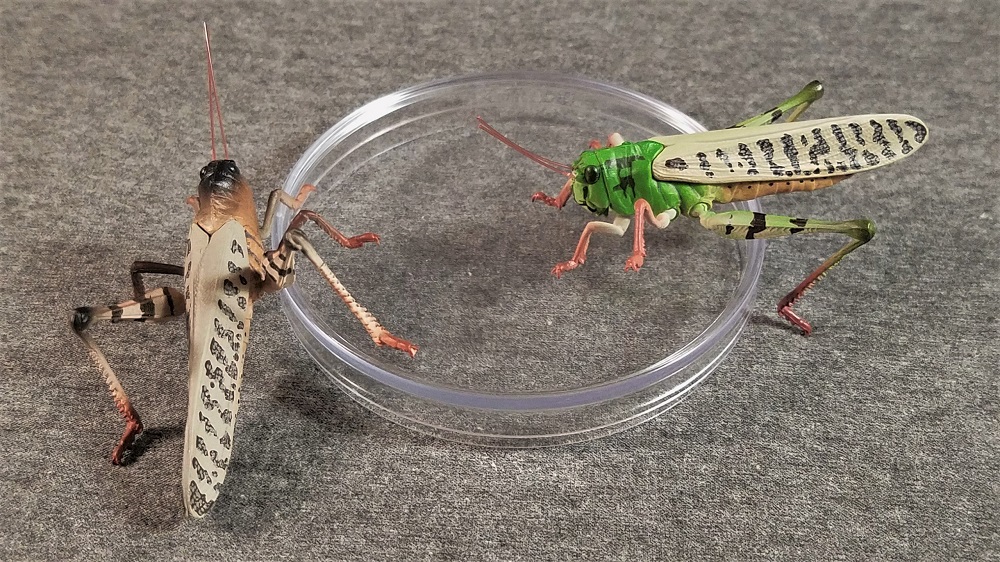
Bandai’s migratory locust figurines measure 55 mm long, which is perfectly within 1:1 scale for female locusts (they range between 40-60 mm in length). The figurines are indeed representative of females, because the abdomens are tipped with pointed ovipositors, rather than blunt sub-genital plates seen in male locusts. Apart from the abdomen, though, male and female locusts are virtually identical in appearance. Like the mantises, the Diversity of Life locust minifigures are superb likenesess to the real insects: every body segment, joint, and plate of exoskeleton is accounted for, with about 7-8 joints in the abdomen, anchored attachments for the legs on the thorax, and distinctive mouthparts on the lower front of the head. A narrow arch is distinguishable on the back of the thorax, and the wings – though not sculpted in transparent plastic – have subtle veined texture which can be felt by running a finger along the sides, or be seen with the right lighting.
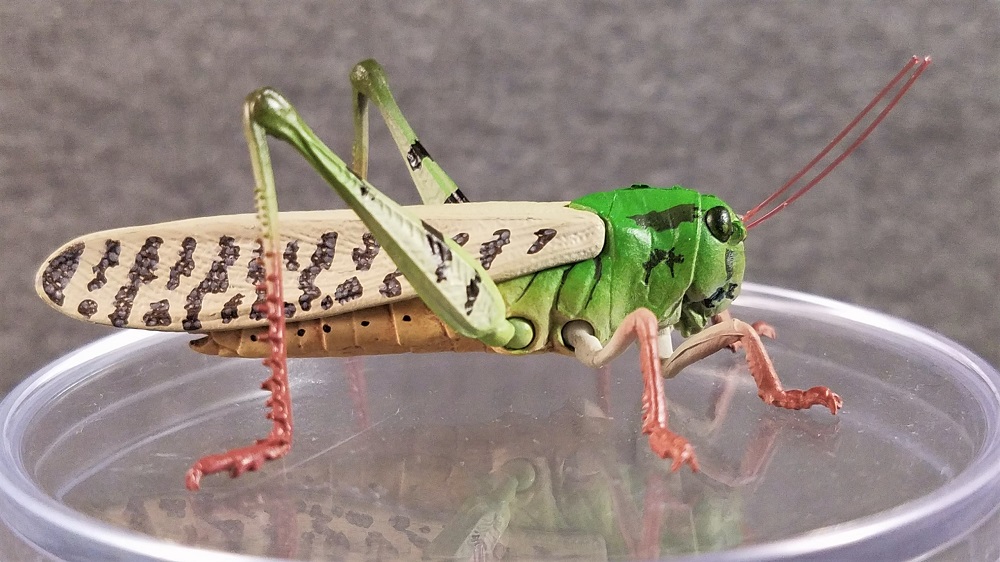
As a bonus feature, the locusts are actually minorly articulated: the middle and rear pairs of legs assemble by way of ball joints attaching to the thorax, allowing for some freedom of movement and a little variety in display. Keep in mind, of course, that these still aren’t meant as toys in the standard sense; any manipulation of the joints should be done with care and gentleness, not altogether unlike how one would need to handle a real insect.
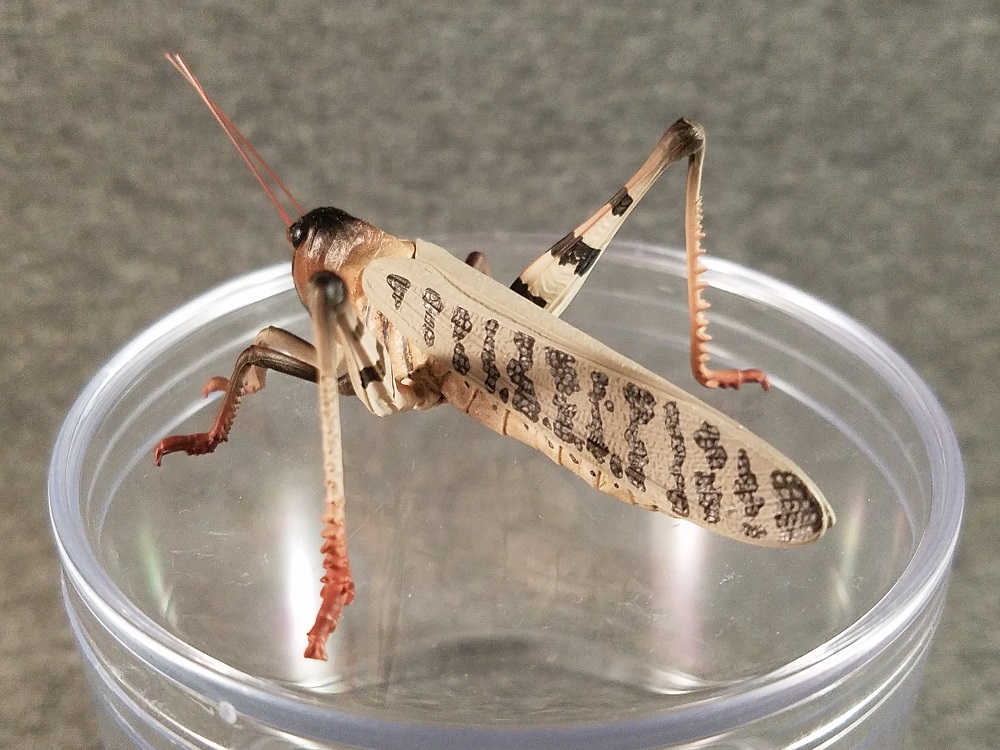
Coloration for the locusts, like the mantises of the set, is predominantly brown or green. The two figurines are nearly dead-on ringers in their color schemes, particularly the green variant. Color patterns may vary in the wild based on age, gregariousness, and even local plant kinds. The green figurine is a rich grass green on the head and thorax, which fades into a pinkish tan on the belly and abdomen. The legs also feature this green-and-tan pattern, with additional pink highlights to the feet. The wings are solid tan for a base – the one feature truly giving away the plastic nature of the figurine – and bears black mottled striping from base to tip. More black stripes mark the head, thorax, and hind limbs almost symmetrically; but on a closer look no two stripes are quite the same.
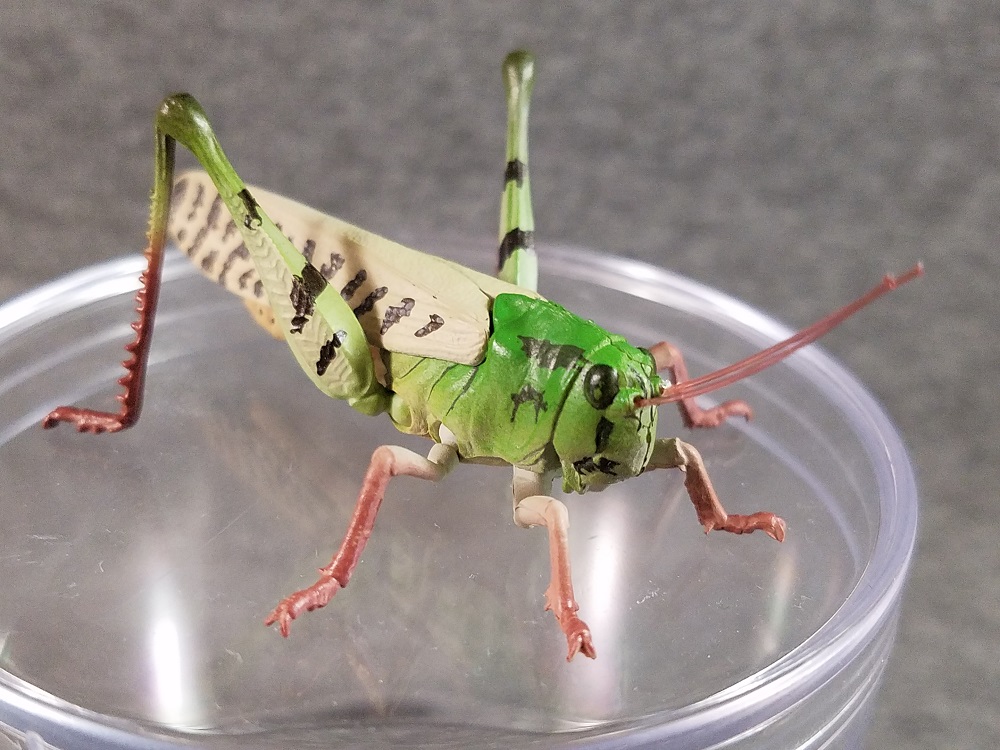
The brown variant of the locust is, well, brown. Dark, earthy brown on the head and legs transitions into tan at the center of the body. Like the green version, there are black mottled patterns on the wings and head; but these patterns aren’t identical to the green locust, nor to either side of their own on the brown locust. The thorax, meanwhile, has no black markings at all. Bandai continues to impress with the subtle details in bringing these insects to life.

There is no shortage of praying mantis replicas in the toy & collectible market, but I think you’ll be hard-pressed to find many as precisely lifelike as those produced under Bandai’s Diversity of Life brand. Migratory locusts have far fewer options available, so recommending this particular set comes all the easier. Bandai’s Ikimono Mini Insect Collection 02 is a sublime set of figurines, even more lifelike than prior Advanced-line sets thanks to their smaller scale and delicate features. These are sure to please any serious insect collectors and impress the casuals too (like me!). While these are not appropriate items for children, I highly recommend it to adult enthusiasts. The set is no longer in production, sadly – supply is often short-lived in the Gashapon market – but you can search Mercari, Yahoo Japan, and eBay for secondhand listings, which can be found for reasonable prices if one is patient.
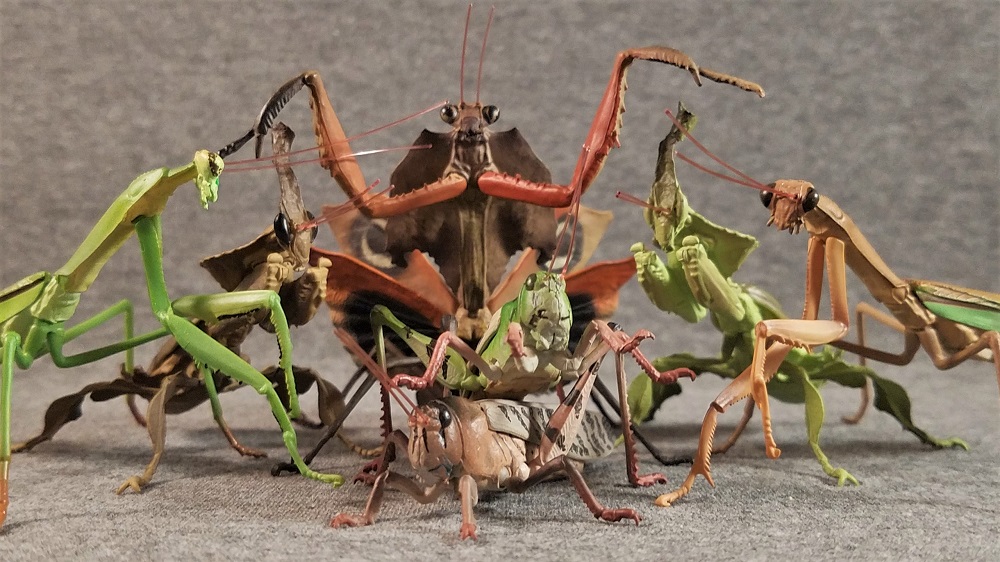
Disclaimer: links to Ebay and Amazon on the AnimalToyBlog are affiliate links, so we make a small commission if you use them. Thanks for supporting us!



